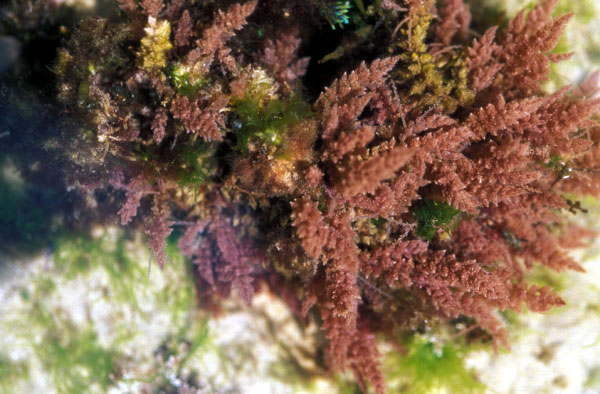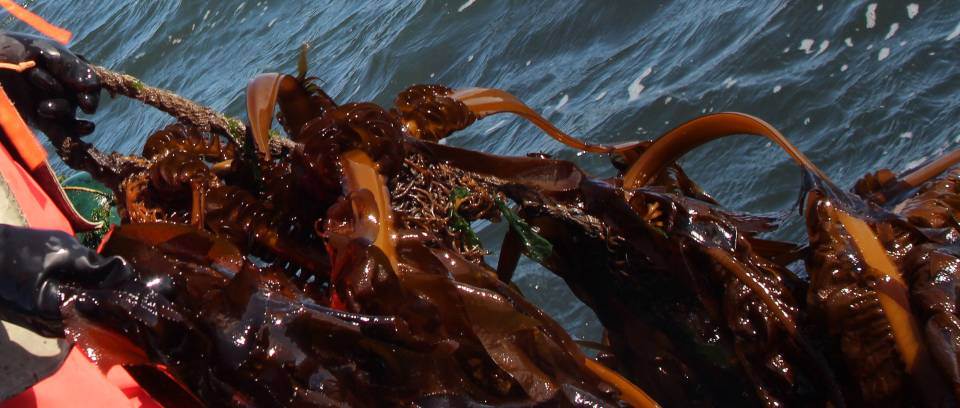The common sea hare Aplysia kurodai is known to be a good source for the enzymes degrading seaweed polysaccharides. Recently four cellulases, i.e., 95, 66, 45, and 21 kDa enzymes, were isolated from A. kurodai (Tsuji et al., 2013). The former three cellulases were regarded as glycosyl-hydrolase-family 9 (GHF9) enzymes, while the 21 kDa cellulase was suggested to be a GHF45 enzyme. The 21 kDa cellulase was significantly heat stable, and appeared to be advantageous in performing heterogeneous expression and protein-engineering study. In the present study, we determined some enzymatic properties of the 21 kDa cellulase and cloned its cDNA to provide the basis for the protein engineering study of this cellulase. The purified 21 kDa enzyme, termed AkEG21 in the present study, hydrolyzed carboxymethyl cellulose with an optimal pH and temperature at 4.5 and 40°C, respectively. AkEG21 was considerably heat-stable, i.e., it was not inactivated by the incubation at 55°C for 30 min. AkEG21 degraded phosphoric-acid-swollen cellulose producing cellotriose and cellobiose as major end products but hardly degraded oligosaccharides smaller than tetrasaccharide. This indicated that AkEG21 is an endolytic β-1,4-glucanase (EC 3.2.1.4). A cDNA of 1013 bp encoding AkEG21 was amplified by PCR and the amino-acid sequence of 197 residues was deduced. The sequence comprised the initiation Met, the putative signal peptide of 16 residues for secretion and the catalytic domain of 180 residues, which lined from the N-terminus in this order. The sequence of the catalytic domain showed 47–62% amino-acid identities to those of GHF45 cellulases reported in other mollusks. Both the catalytic residues and the N-glycosylation residues known in other GHF45 cellulases were conserved in AkEG21. Phylogenetic analysis for the amino-acid sequences suggested the close relation between AkEG21 and fungal GHF45 cellulases.
Digital library
-
-
Considerable work has been done on the chemical aspects of Indian seaweeds during the last three decades, of which those up to 1970 have been reviewed by Umamaheswara Rao (1970). In this chapter the information so far collected on the mineral constituents, carbohydrates and other chemicals is presented.
-
Considerable work has been done on the chemical aspects of Indian seaweeds during the last three decades, of which those up to 1970 have been reviewed by Umamaheswara Rao (1970). In this chapter the information so far collected on the mineral constituents, carbohydrates and other chemicals is presented.
-
Seaweeds in general derive their importance from their carbohydrate content. Part of the carbohydrate is in the form of cellulose which cannot be hydrolysed by ordinary means; and the rest in the form of polysaccharides either as agar or as algin, the latter being considered as a polymerised form of d-mannuronic acid. Kylin (1913) is of the opinion that simple reducing sugars constitute the first products of photosynthesis and that they occur in very small quantities.
-
Greenhouse gas levels are on track to exceed the worst-case scenario. But, as world leaders meet in Paris for the UN climate summit this month, Tim Flannery argues that there are still realistic grounds for hope
-
The general distribution of seaweeds along the east and west coasts of India, Lakshadweep and Andaman-Nicobsr islands is given. The standing crop of seaweeds in all these areas is estimated as more than 1,00,000 tons (wet wt.). The quantity of seaweeds growing in the shallow water areas (0 to 4.0 m depth) of southwest coast of Tamil Nadu was estimated as 22,000 tons (wet wt.) in an area of 17,125 ha and from deep waters (5.0 to 22.0 m depth) was 75,372 tons (wet wt.) from an area of 1,863 sq.km. Monthly data were collected during the four years 1989,1990,1992 and 1993 from different seaweed ,landing Centres in Tamil Nadu coast on the quantity of seaweeds harvested from the natural seaweed beds.
-
Pulse amplitude modulation (PAM) fluorometry is ideally suited to measure the sub-lethal impacts of photosystem II (PSII)-inhibiting herbicides on microalgae, but key relationships between effective quan- tum yield [Y(II)] and the traditional endpoints growth rate (l) and biomass increase are unknown. The effects of three PSII–inhibiting herbicides; diuron, hexazinone and atrazine, were examined on two trop- ical benthic microalgae; Navicula sp. (Heterokontophyta) and Nephroselmis pyriformis (Chlorophyta). The relationships between Y(II), l and biomass increase were consistent (r2 P 0.90) and linear (1:1), validat- ing the utility of PAM fluorometry as a rapid and reliable technique to measure sub-lethal toxicity thresh- olds of PSII-inhibiting herbicides in these microalgae. The order of toxicity (EC50 range) was: diuron (16–33nM)>hexazinone (25–110nM)>atrazine (130–620nm) for both algal species. Growth rate and photosynthesis were affected at diuron concentrations that have been detected in coastal areas of the Great Barrier Reef.
-
The biomass production and biochemical properties of marine and freshwater species of green macroalgae (multicellular algae), cultivated in outdoor conditions, were evaluated to assess the potential conversion into high-energy liquid biofuels, specifically biocrude and biodiesel and the value of these products. Biomass productivities were typically two times higher for marine macroalgae (8.5–11.9 g m2 d1, dry weight) than for freshwater macroalgae (3.4–5.1 g m2 d1, dry weight). The biochemical compositions of the species were also distinct, with higher ash content (25.5–36.6%) in marine macroalgae and higher calorific value (15.8– 16.4 MJ kg1) in freshwater macroalgae. Lipid content was highest for freshwater Oedogonium and marine Derbe- sia. Lipids are a critical organic component for biocrude production by hydrothermal liquefaction (HTL) and the theoretical biocrude yield was therefore highest for Oedogonium (17.7%, dry weight) and Derbesia (16.2%, dry weight). Theoretical biocrude yields were also higher than biodiesel yields for all species due to the conversion of the whole organic component of biomass, including the predominant carbohydrate fraction. However, all marine species had higher biomass productivities and therefore had higher projected biocrude productivities than freshwater species, up to 7.1 t of biocrude ha1 yr1 for Derbesia. The projected value of the six macroalgae was increased by 45–77% (up to US$7700 ha1 yr1) through the extraction of protein prior to the conversion of the residual biomass to biocrude. This study highlights the importance of optimizing biomass productivities for high-energy fuels and targeting additional coproducts to increase value.
-
Thallus erect or prostrate (decumbent), branched subdichotomously, laterally, secondly, radially or irregularly; axes and branches terete to flattened. Attached to solid substratum by a small discoid holdfast or living on sandy bottoms with part of the thallus immersed in the sand. Sometimes loose lying or floating in calm waters. Uniaxial construction but appearing multiaxial, pseudoparenchymatous with a small celled medulla.
Life history triphasic with isomorphic gametophytes and tetrasporapytes. In the genus Gracilaria, cystocarps exhibit traversing nutritive cells between the carposporophyte and the pericarp and spermataagia are in pits or conceptacles. In the genus Gracilariopsis, cystocarps lack the traversing nutritive cells and spermatangia are superficial. -
Even with seaweed aquaculture growing rapidly over the last decade, global demand for seaweed-based products has surpassed supply. There is a large and diverse array of applications and uses of macroalgal products. The seaweed industry is estimated to have an annual value of some US$6 billion, the largest share of which (US$5 billion) is human food products. The remaining US$1 billion is largely based on seaweed extracts, such as hydrocolloids for use in animal feeds, fertilizers and bioactives.





